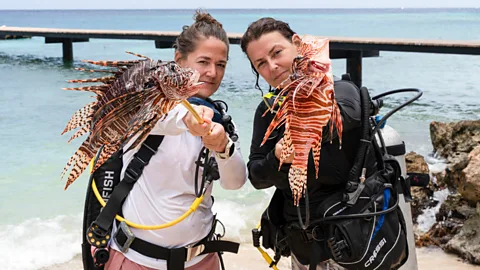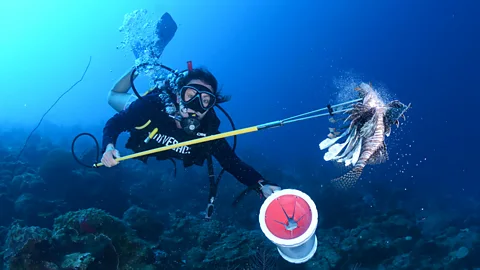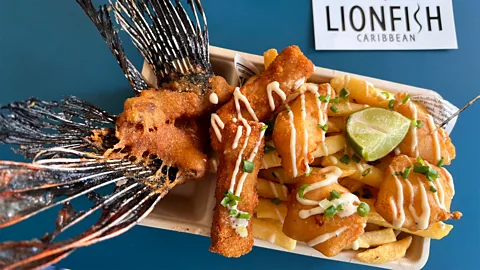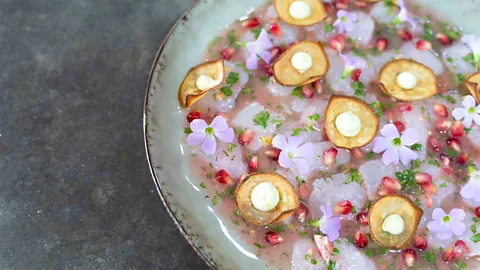The fearless lionfish huntresses of the Caribbean
 Charmed Life Photography-Lisa Haynes
Charmed Life Photography-Lisa HaynesTwo women are working to save the coral reef from the invasive lionfish, using it as a sustainable teaching tool and cooking it into everything from tacos to fish and chips.
Curacao is facing an ecological challenge: the invasive lionfish. The venomous lionfish have brown, red and white zebra-like stripes, fleshy tentacles and long, fan-like fins. They are native to the South Pacific and Indian Oceans, but sometime in the late 1980s they were introduced to the warm tropical waters off Florida's Atlantic Coast. Although the exact cause of this is unknown, it's theorised that they were released from marine aquariums. By the early 2000s, they had reached the Caribbean coastline and Curacao's coral reef, where diving significantly contributes to the local economy and employment.
Lionfish are not a welcome species anywhere because they reproduce at an alarming rate; females release about two million eggs per year and as they grow, they eat smaller native fish and marine life that protect coral reefs. This behaviour creates an imbalance that disrupts the reef's ecosystem. The presence of lionfish impacts both diving tourism and the commercial fishing industry, with research showing that even in a short period of time, the presence of lionfish can reduce a native reef fish population by 79%.
But what is problematic has become a catalyst for innovative adaptation and environmental responsibility. Through food, art and education, the unique but complicated relationship between Curacao and its lionfish is being tackled by two local women, Helmi Smeulders and Lisette Keus.
Smeulders left her law career in the Netherlands in 1998 and relocated to Curacao, eventually becoming a chef, diver and conservationist. But what did a lawyer-turned-chef know about hunting the invasive lionfish, sustainable fishing and the importance of protecting the reef for future generations? Turns out not much, until she teamed up with local diver Keus, who taught Smeulders (along with other women on the island) how to find and capture the lionfish to help save the coral reef. "I showed [chefs] how to clean them, gave [them] recipes and gave batches [of the fish] for free to restaurants to practise with," says Keus.
 Turtle and Ray Productions
Turtle and Ray ProductionsAfter coming across the fish during dives years earlier, Keus decided to dedicate herself to controlling its population. She excelled at catching it and became known as somewhat of a lionfish whisperer as she always seemed to know exactly where to find the elusive creature. In 2012, she started trying to sell the fish to restaurants.
At first it was a challenge. No one wanted to buy (or eat) the fish because they were believed to be poisonous (they're actually only venomous; the fins on their back sting when touched and can cause swelling and pain). "Everyone was afraid of [the fish] and they didn't know if it was safe to touch or eat," she says. "I had my cooler full but I found myself throwing pounds of fish back into the ocean because I couldn't sell it. "
World's Table
BBC.com's World's Table "smashes the kitchen ceiling" by changing the way the world thinks about food, through the past, present and future.
Keus devised a way to make the fish palatable to local chefs. "I explained that lionfish are an invasive species, so by cleaning it safely and serving it, they were actually helping to protect the local Curacao ecosystem," she says.
As Keus's lionfish business grew, she wanted to address another issue: waste. After removing the venomous, spiny parts of the fish, only about 20% of each lionfish was left for consumption. Keus started asking restaurants for the fish fins back to make jewellery. She opened a retail store called Lionfish Caribbean in 2016, located in Kura Hulanda Village, selling hand-made lionfish jewellery and providing education and training to divers and tourists about the invasive species. She also opened a tasting room serving lionfish tacos and fried lionfish and chips.
Their tagline? "We eat them to beat them."
 Charmed Life Photography-Lisa Haynes
Charmed Life Photography-Lisa HaynesSmeulders is also a big proponent of cooking lionfish, which she first started doing in 2013 when she cooked at a large dinner reception for the King and Queen of the Netherlands during their visit to Curacao. With a reputation for using exclusively local ingredients, Smeulders’ decision to include the lionfish was not only logical, but a beneficial and sustainable menu choice.
Curacao Lionfish Derby
Each October, Lionfish Caribbean is the official host of the Curacao Lionfish Derby, which includes hunts and tournaments. In addition to an ocean and conservation market, there are cash prizes offered for the divers that manage to bring back the most lionfish at the end of each event.
Smeulders reached out to Keus and other divers with a request to catch as many lionfish as possible for the dinner. Then? "I did what I do best: I served a plate of small bites with a modern Caribbean flair," she says. Her poached lionfish, prepared with a rich and buttery hollandaise sauce and hint of lemon, was the standout. Because lionfish is a white fish with a mild, delicate flavour that's somewhere between cod and lobster (and a good source of omega-3 fatty acids) "it helped capture the essence of the island's unique cuisine," says Smeulders.
Beyond cooking lessons and full stomachs, Smeulders shares her own dives and lionfish hunting adventures with her students and has become a fearless lionfish huntress in her own regard. She uses the lionfish to teach about sustainability and environmental responsibility, encouraging people to consider the ethical side of consuming the fish that's given up its life. She hopes it reminds people of their own role in the food chain, fostering a direct relationship with the environment and the cycle of life. She's written two cookbooks and also offers Chef's Table events where people can watch Smeulders and her team work.
More like this:
• A Caribbean secret to happiness
"Some of my favourite recipes to use lionfish are flavourful ceviches,” Smeulders says. "I also like it as a tartare, tacos and I use the bones to make a good stock." She goes on to explain, "we can use the spine as well because it's protein. We heat the spine for 20 minutes at 200C and it neutralises the venom. You can use [the spine bones] as little scores [picks]".
These two dynamic lionfish huntresses are fearless to no end. They each admit to being addicted to the thrill of it. "If you wake up and realise it's a day you get to go lionfish hunting," says Smeulders, "then it's definitely going to be a good day."
 Charmed Life Photography-Lisa Haynes
Charmed Life Photography-Lisa HaynesTequila and Passionfruit Lionfish Ceviche recipe
By Helmi Smeulders
Serves 4
Ingredients
¼ cup fresh lime juice
2 tbsp tequila
1 passionfruit, seeds and juice only (pulp)
2 tbsp fresh coriander, finely chopped
1 tsp fine sugar
¼ tsp finely minced scotch bonnet chilli
⅛ tsp salt
⅔lb fresh lionfish fillet (thinly sliced)
1 tbsp pomegranate seeds, for garnish
Method
In a medium bowl, mix the lime juice and tequila with the passionfruit pulp, coriander, sugar, chilli and salt. Arrange the fish on a serving plate. Spoon the dressing over the fish. Briefly refrigerate to chill the fish. Garnish with the pomegranate seeds before serving.
--
If you liked this story, sign up for The Essential List newsletter – a handpicked selection of features, videos and can't-miss news, delivered to your inbox twice a week.
